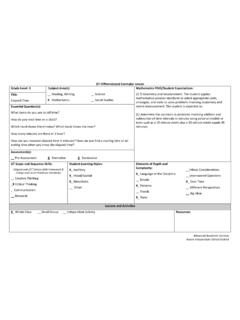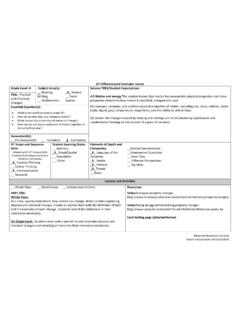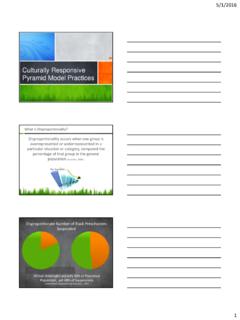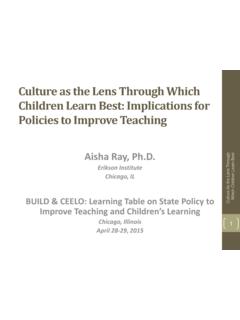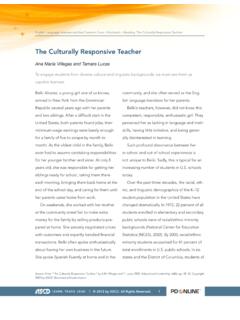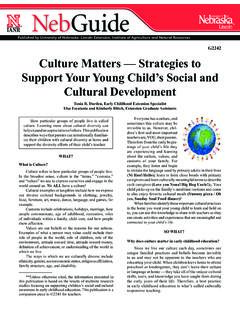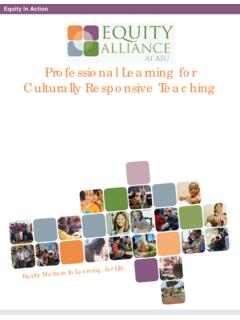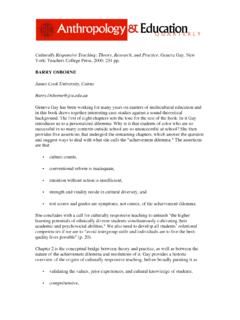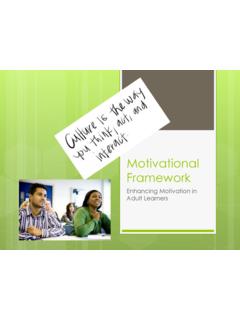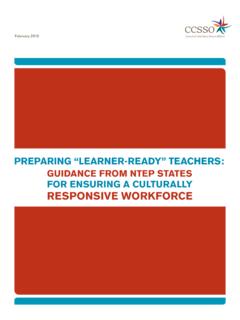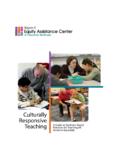Transcription of Why Culturally responsive teaching? - curriculum.austinisd.org
1 Why Culturally responsive teaching ? We are all born, raised and enveloped in culture, and it is central to learning. It informs how we communicate with each other, the way we receive information and helps shape the thinking process of groups and individuals. Culturally responsive teaching recognizes the importance of including students' cultural references in all aspects of learning, enriching classroom experiences and keeping students engaged.. - teaching Tolerance Culturally responsive teaching helps to bridge different ways of knowing and engages students from non-dominant cultures in demonstrating their proficiencies Further, by understanding the features of this knowledge, students from non-dominant cultures can learn how to translate the logical structures of their knowledge and map them onto the school curriculum. By bringing alternative ways of knowing and communicating into schools, the curriculum as well as the students benefit. Culturally responsive teaching creates these bridges and in doing so, offers the possibility for transformational knowledge that leads to socially responsible action.
2 - Equity Alliance, Culturally responsive teaching Matters HOW Can I cultivate a Culturally responsive curriculum? 1. KNOW YOUR STUDENTS!!! The better you understand their interests and cultures, the better you can promote them in the curriculum. Additionally, it is important to . 2. KNOW YOURSELF!!! Recognize how your cultural identity affects your behavior, especially in the classroom. Remember: All instruction is Culturally responsive . The question is: to which culture is it currently oriented? . - Gloria Ladson-Billings, The Dreamkeepers 3. Start by placing marginalized groups at the center of INQUIRY. Teach students the dominant narrative first, and then add information prompting students to question that narrative by analyzing the stories and experiences of groups and individuals on the margins of the historical narrative. Examining the experience of marginalized groups encourages us to view well-known topics in NEW WAYS, as well as bring NEW TOPICS and NEW ANALYSES of historical developments into focus.
3 4. Create NEW CATEGORIES of analysis. New categories of analyses allow us to better understand the complexity of historical events and problematize the dominant narrative. Making AGE, GENDER, RACE, CLASS and ETHNICITY. categories of analysis also promotes STUDENT CHOICE and their ability to see themselves in the curriculum. New SUBCATEGORIES should also be considered. For example, definitions of childhood, youth, teen and young adult are fluid not fixed. The addition of BIOLOGICAL, LEGAL, and CULTURAL definitions of AGE, GENDER, RACE, CLASS and ETHNICITY encourages deeper analysis and historical thinking. 5. Examine the LIVED EXPERIENCES and ORDINARY DAILY LIVES of people as a window into the subjective experience of others so that it's more likely students will find themselves in the story of history. 6. Remember the importance of SOURCING!!! Sources created by YOUTH PRODUCERS for YOUTH CONSUMERS may have additional value and be DIVERGENT from the more dominant adult-focused narratives.
4 This also applies for sources created for and consumed by gender, racial, and ethnic groups. SOURCING can uncover important information about prescriptive demands and divergent behaviors among groups in which power and authority are in play. Including these divergent sources promotes historical thinking and inquiry. 7. Ask the RIGHT QUESTIONS Now that you are ready to place marginalized narratives at the center of historical inquiry, it is important to focus that inquiry around the right questions. In what ways did social arrangements, beliefs, practices, ideologies and historical forces shape ideas about youth, race, gender, class and/or ethnicity? How do age, race, gender, class, ethnicity, nationality, religion and region influence and interact with one another (in a given context)? What evidence is there for multiple notions about youth, race, gender, class and/or ethnicity? Is there a DOMINANT construct coexisting or contending with ALTERNATIVE ideas? What might you anticipate the members of a specific age, race, gender, class or ethnic group will think and feel based on the dominant narrative?
5 (After looking at a divergent source) How did this new information change your initial idea? How is a specific age, race, gender, class or ethnic group represented in dominant media? How are they described? How are they characterized? WHY? You can access resources at Austin ISD Social Studies Melanie Kirchhof, High School Social Studies Specialist, Amber Rinehart, Social Studies Curriculum Technology Specialist.

